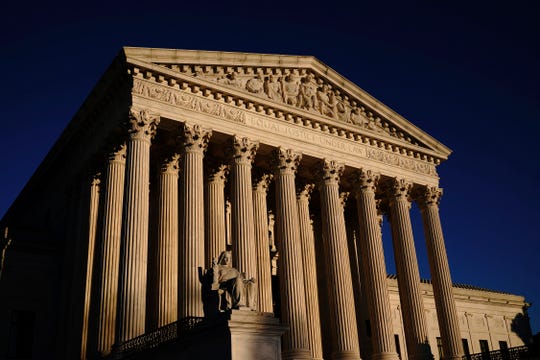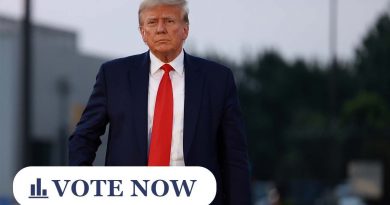Supreme Court wrestles with complex questions of tribal power arising from late-night traffic stop
WASHINGTON – The Supreme Court on Tuesday wrestled with a dispute over when Native American police officers may detain non-Native suspects, delving into thorny issues of tribal sovereignty that have vexed the federal government for generations.
The case arrives at the nation’s highest court a year after the justices found that the eastern half of Oklahoma is Native American territory. That suit concerned an appeal from a Native American who claimed his state rape conviction from 1997 should be overturned because Oklahoma lacked jurisdiction.
This time, the justices are looking in the opposite direction: Confronting difficult questions about whether a tribal police officer went too far in his interaction with a non-Native. The suspect, later found to be in possession of meth and firearms, had stopped his vehicle inside a reservation – but on a federal highway.
Tribal law disputes at the court often involve a complicated stew of federal law, treaties and powers recognized for other sovereign entities – a legal morass that underscores the knotty relationship the federal government has had with Indigenous tribes. The cases can make for unusual splits, too. In last year’s case, Associate Justice Neil Gorsuch, President Donald Trump’s first nominee, sided with the court’s liberals and wrote the majority opinion.
After more than an hour of oral argument Tuesday, it was not clear which way the court is leaning – though both conservative and liberal justices peppered attorneys with a series of hypotheticals probing the impact of a potential ruling that tribal officers are powerless to detain non-Natives traveling through a reservation.
The case stems from an interaction that took place in the middle of the night in 2016. James Saylor, a highway safety officer for the Crow Police Department, approached a vehicle stopped on U.S. Route 212 in the Crow Indian Reservation in southern Montana. As Saylor began to question the driver, Joshua Cooley, he grew suspicious of his answers and the situation became more confrontational. Saylor noticed two semiautomatic rifles on the passenger seat of Cooley’s truck.
As Cooley fished through his pocket for his driver’s license, Saylor said Cooley’s breathing became shallow and that he “stared straight forward.” Saylor recognized the “thousand-yard” stare as a signal of potential violence and unholstered his pistol.
The Supreme Court will hear arguments Wednesday in Caniglia v. Strom on whether police can enter a home without a warrant. (Photo: J. Scott Applewhite/AP)
Saylor moved to the passenger side of the truck and opened the door, revealing a semiautomatic pistol near Cooley’s hand. Saylor moved Cooley and a child who was also in the truck to his patrol car and, in the course of patting Cooley down and searching the vehicle, found methamphetamine and other drug paraphernalia.
Cooley was ultimately charged with drug and firearm crimes.
Cooley sued to toss the evidence, arguing Saylor acted outside his jurisdiction when he pulled his weapon – an act that amounted to a seizure of Cooley – and ordered him out of his truck.
The California-based U.S. Court of Appeals for the 9th Circuit agreed, finding Saylor was out of bounds because he didn’t first determine if Cooley was Native American. Once a tribal officer establishes a suspect is not a Native American, his options are limited. To conduct a search, the appeals court found, Saylor would have needed to determine that Cooley was involved in an “obvious” or “apparent” crime.
The federal government, which sided with the tribal officer in the case, appealed to the Supreme Court in June.
“Through decades of consistent opinions, this court has delineated the scope of (tribal police) authority to exclude police power over non-Indians, especially on non-tribal lands such as the public right of way here where Officer Saylor seized and searched Mr. Cooley,” Eric Henkel, Cooley’s attorney, told the court.
But the federal government, under both the Trump and Biden administrations, argued the standard laid out by the appeals court is unworkable and would make it impossible for tribal officers even to police Native Americans, let alone non-Natives or situations where a suspect’s race or ethnic background is not clear. That’s partly because it is difficult to prove whether a person is Native American, the Justice Department told the court.
“I take it that if someone were driving around with a bumper sticker that said ‘I am not an Indian,’ they couldn’t be stopped,” quipped Eric Feigin, the deputy solicitor general, as he argued against the standard embraced by Cooley’s lawyer.
The appeals court decision, Feigin said, created “an unprecedented standard that nobody is going to know how to apply – officers or courts.”
That argument appeared to resonate with Associate Justice Stephen Breyer.
“You can’t just look at them and see whether they’re Indians or not – people look different,” Breyer said. “So I think that would be a tough one to do.
Several justices – conservative and liberal – tossed a series of hypotheticals at Cooley’s lawyer. What if the non-Native suspect was believed to be a serial killer? What if the tribal officer believed the person behind the wheel was drunk and posed a threat to other drivers? What if the officer observed a bloody knife in the car shortly after a report of a Native American stabbed? Would the tribal police officer just have to walk away?
“It does seem to me that determining whether a person is an Indian…may be more difficult than you suggest,” Associate Justice Samuel Alito told Henkel.
‘Not surprised’: Justice Alito defends controversial speech as he marks 15 years on Supreme Court
Alito posed a hypothetical about a clearly non-Native drunk driver. Can the officer ask the driver to perform a field sobriety test?
“I don’t believe so,” Henkel responded. “No, he can’t.”
So the officer has to let the person drive off, Alito asked.
“He could certainly ask the individual to stay there while he contacts law enforcement. But can he official detain? No, I do not think so.”
In situations involving an “ongoing active breach of the peace where public safety is in jeopardy” – such as in the hypotheticals involving a serial killer or a bloody knife – that would meet the appeals court standard of an apparent crime, Henkel said.
Henkel asserted that many Native American tribes have cooperative agreements with local and federal police that give them additional authority to conduct stops and temporarily detain suspects on reservations. But such an agreement wasn’t in place when Saylor began questioning Cooley.
“To the extent this absence of tribal police authority creates a jurisdictional gap in reservation law enforcement, Congress has already filled the gap by providing for cross-deputization of tribal officers,” Henkel said. “Mr. Cooley does not challenge tribal sovereignty. He simply asks that the boundaries of tribal sovereignty be respected as this court has previously defined them.”
Source: Read Full Article


